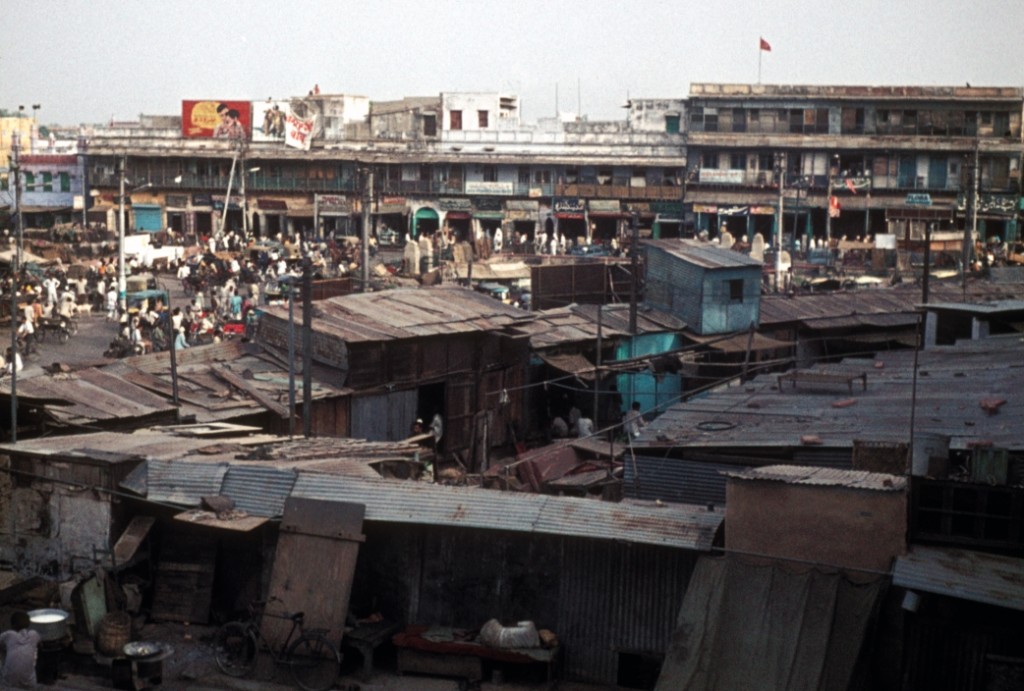
Source: http://commons.wikimedia.org/wiki/File:1973_Delhi_Slum.jpg
I just put down Mike Davis’ haunting book about urban poverty, Planet of Slums. (We will likely be reading another of Davis’ fine books this summer in my elective course, “Environmentalism and the Poor.”) In Planet of Slums, Davis recounts the late twentieth-century history of how “second world” and “third world” states—lured on by “first world” incentives—adopted neoliberal privatization schemes that dispossessed the rural poor and sent hundreds of millions of people flying into outsized urban ghettos. World poverty is now more an urban phenomena than a rural one, Davis writes, and more humans today live in “slums” than at any other time in human history.
This leads me, an environmental historian, to wonder: whose environments matter? What I mean is: when we talk about “environmental” issues, or we engage in debates over how best to protect the “environment,” whose environments are we really talking about? Do we care most about protecting flora and fauna, air quality and water quality, work environments, slums? And what do we mean by “protection”? Protection from whom? In his book Crimes Against Nature, historian Karl Jacoby shows that late nineteenth-century efforts to protect wilderness in the United States really amounted to a class war: a series of battles waged by affluent conservationists against the poor people who already lived and worked within those woods. Creating “wilderness,” Jacoby reasons, necessitated removing indigenous and working-class peoples first. This same theme was echoed in Ramachandra Guha’s aptly titled classic, The Unquiet Woods, about indigenous and working-class resistance to forest conservation in India. The take-away here is that whenever we think about “environment,” we ought to ask “whose environment” and then we might try and listen and see if we can’t hear the “unquiet” of those marginalized peoples whose ideas about “environment” perhaps differ from our own.
But the question “whose environments matter” does not simply apply to woods and waters, the traditional subject matter of environmental scientists, humanists, and policy makers. This question also forces us to reconsider which (and whose) environments are most worthy of our attention. In Planet of Slums, Davis’ chapter “Slum Ecology” does just that. The writer takes us inside of the world’s worst concentrations of urban poverty to understand how slums environments work. They are geographically situated on top of fault lines, on eroded and unstable hillsides, and in stagnant bottomlands where untreated water is never flushed out and the “modern” convenience of toilets is almost wholly unknown. Slum environments, Davis writes, are unusually prone to deadly fires, rampant disease epidemics, and worst of all, unbridled military and police repression. States love to “clean up” slums—U.S. history is full of such examples—and poor people are consequently displaced over and over again in a cycle of violence, poverty, and economic and political marginalization.
But to understand the linkages among poverty, globalization, and the environment, it is not enough just to study (and seek to fix) slum environments. We also must understand what forces have caused—and continue to cause—the largest rural-to-urban mass migration in human history. This summer, I hope that we may read a short selection from Hsiao-Hung Pai’s recent book, Scattered Sand. Pai, a journalist, traveled for years among China’s “floating population”—the hundreds of millions of rural peasants who since economic reforms of the 1980s have left the countryside and moved into urban work environments. Environmental transformations—such as the commoditization and export of local resources, and even the creation of wilderness areas and the initiation of environmental management programs meant to provide clean air, water, and housing— have sometimes had crippling effects on the world’s poor: farmers dispossessed, locally-based economies ruined, and working peoples left in the cold with no social safety net to fall back on. Whereas Karl Marx theorized that capitalism would soon turn the world’s rural peasantry into a massive urban proletariat, Mike Davis, in Planet of Slums, suggests that in most cases, that never really happened. Instead, enclosure and dispossession led only to high levels of unemployment, informal “black market” economies, and megacity-sized slums.
For those of us who care about the “environment” and “environmental issues,” this line of thinking only leads to further questions rather than answers. Should we focus on urban, rural, or wild environments? Should we study plants, animals, or people? Land, water, or air? Where does the solution to global poverty lie? And how are terms such as “poverty,” “globalization,” and “capitalism” not only interconnected but also reified in the real-world environment around us? Can we see it in our local forests? Can we hear it in the song of the loon? Can we taste it in our morning coffee or feel it in the evening breeze? At the School of the Environment we will explore these questions.